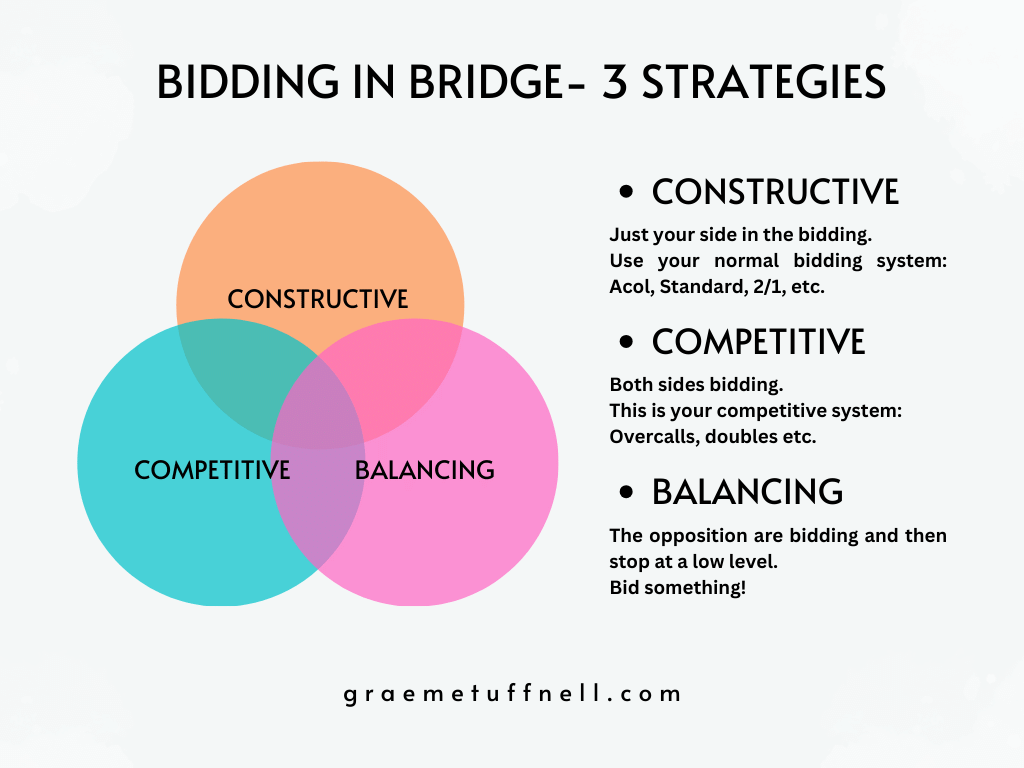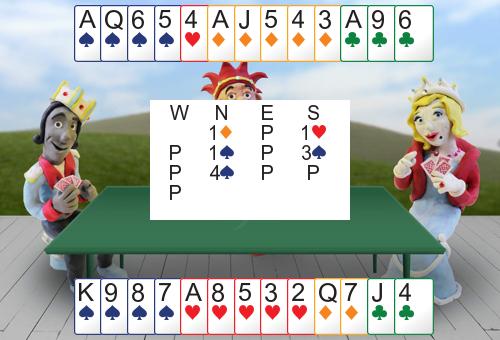Improve your bidding in bridge
There are three bidding strategies you will need, depending on who has the points and what has happened in the auction so far.
We'll want to bid and make play a part-score, game or slam on many hands but making a contract isn't always our only objective. Sometimes we can profitably go down in our contract, called sacrificing, to prevent the opposition from making a bigger score for making a contract their way.

We need bidding strategies to cover every situation. There's often overlap, of course, and auctions will sometimes have elements of two or even all three stratgeies to consider.
You and your partner will need to recognise what type of auction you're dealing with and bid accordingly.
Constructive Bidding
When just you and your partner are in the auction it's all about constructive bidding. You'll be trying to decide whether to play in a suit or notrump contract and whether to play in a partscore, game or slam.
This is where you'll be using a bidding system such as Acol, Standard American, 2/1, Precision or even something else.
On the following hand North and South have a constructive auction to 4♠.

Opening Bids and Responses
Regardless of what bidding system you use, bridge is a lot easier when you understand the logic behind all those bids.
Competitive Bidding
In competititive auctions, where both sides are bidding, your combined trump length is a good indication of how high you should be bidding. For that reason, showing your suit length as quickly as possible with an overcall or double helps partner to make better bidding decisions.
Other hand evaluation techniques will help you to decide if you'll make your contract whereas trump length helps you decide whether the contract you bid to will be a good sacrifice.
The better your trump fit, the higher you should be competing.
On the following hand each side has a 10-card fit. This means that it is a good idea to bid for 10 tricks. Note that it doesn't guarantee that you will make the contract, only that it is a good idea to bid it! You'll either make your contract or it will be a good sacrifice.

East West can make 4♥ and North South are only 1 down in 4♠. It's better for North and South to give East and West 100 points for going down our way rather than 620 (or 420) for letting them make game.
Balancing
When the opposition have been doing all the bidding but then stop at a low level you will sometimes want to get back into the auction. That's known as balancing. It takes courage but learning to balance at the right time will help your scores a lot.
Having a trump fit is great! A fit just means a suit that we've got at least eight of between our two hands. The bigger our fit, the higher we can afford to compete. If our side has opened the bidding, we are normally going to be able to work out pretty quickly whether or not we have a fit and how good our fit is.
Even if the opposition have opened the bidding, if we can overcall or double to show something about our hand, again, we're going to get an idea of whether or not we've got a fit. But sometimes there just doesn't seem to be anything to say.
Luckily a tiny little bit of knowledge about bridge odds tells us what we need to know. If they have a fit, we probably have a fit.
Did we bid ok?
Did we make a mistake? Were we just unlucky? Or lucky?
Forget what the actually happened at the table and don't look at the oppositions' cards. Just look at your hand and partner's and compare to the chart below. Don't let the actual result influence you one way or the other.

The result of one hand often doesn't tell us much. We're looking for a long term winning strategy.
tags: #constructivebidding #competitivebidding #balancing
